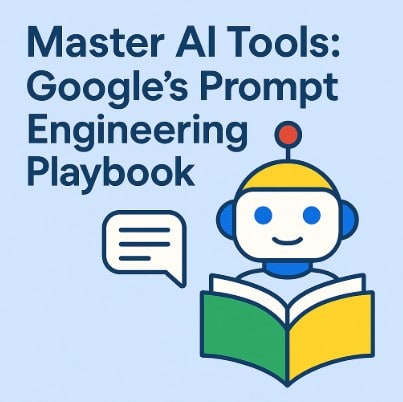The landscape of artificial intelligence is rapidly evolving, and mastering its tools is no longer a luxury but a necessity for professionals in technology. Google’s new Prompt Engineering Playbook offers a comprehensive guide to effectively interacting with AI models, unlocking their full potential. This guide is invaluable for intermediate to advanced Linux users, DevOps engineers, cloud engineers, DBAs, backend developers, AI/ML engineers, system administrators, automation engineers, infrastructure developers, and IT managers and architects. This article will delve into the playbook, providing practical examples and insights crucial for harnessing the power of AI in your daily workflows.
Table of Contents
- 1 Understanding Google’s Prompt Engineering Playbook
- 2 Key Concepts from the Playbook
- 3 Use Cases and Examples
- 4 Frequently Asked Questions (FAQ)
- 4.1 Q1: What AI tools are compatible with the principles in Google’s Prompt Engineering Playbook?
- 4.2 Q2: How do I measure the effectiveness of my prompts?
- 4.3 Q3: Are there any specific best practices for using the playbook in a DevOps context?
- 4.4 Q4: What are some common pitfalls to avoid when using prompt engineering?
- 4.5 Q5: Where can I find more information and resources on Google’s Prompt Engineering Playbook?
- 5 Conclusion Master AI Tools
Understanding Google’s Prompt Engineering Playbook
Google’s Prompt Engineering Playbook isn’t a physical book; it’s a collection of best practices and techniques for crafting effective prompts to elicit desired responses from large language models (LLMs) and other AI tools. This is crucial because the quality of the output from an AI system is heavily dependent on the quality of the input – the prompt. The playbook addresses this directly, providing guidance on structuring prompts, specifying constraints, and iteratively refining them for optimal results. This isn’t just about getting the AI to work; it’s about getting it to work efficiently and effectively, saving time and resources.
Why is this Playbook Important for Tech Professionals?
For tech professionals, mastering prompt engineering translates to increased efficiency and productivity across various tasks. Imagine using AI to automate repetitive tasks, generate code snippets, debug complex issues, or even design entire system architectures. The playbook helps you bridge the gap between human intention and AI execution, enabling you to leverage AI’s capabilities to their fullest extent.
- Automation of repetitive tasks: Generate scripts, automate documentation, and streamline workflows.
- Code generation and debugging: Quickly create code, identify errors, and improve code quality.
- System design and optimization: Explore design possibilities, analyze system performance, and identify bottlenecks.
- Data analysis and interpretation: Extract insights from large datasets and gain actionable intelligence.
- Enhanced collaboration and knowledge sharing: Use AI to synthesize information from diverse sources.
Key Concepts from the Playbook
Prompt Structure and Clarity
The playbook emphasizes the importance of well-structured and clear prompts. Ambiguity leads to unpredictable results. A well-structured prompt typically includes:
- Clear instructions: Specify exactly what you want the AI to do.
- Contextual information: Provide relevant background information to guide the AI.
- Constraints and limitations: Define the boundaries within which the AI should operate.
- Desired output format: Specify the format you expect (e.g., JSON, Python code, plain text).
Iterative Refinement
The playbook advocates for an iterative approach. You don’t get the perfect prompt on the first try. Expect to experiment, analyze the AI’s responses, and refine your prompts based on the results. This iterative process is crucial for achieving optimal performance.
Few-Shot Learning
Few-shot learning involves providing a few examples in the prompt to guide the AI’s behavior. This is particularly useful when dealing with complex tasks or nuanced requirements. For instance, if you want the AI to translate code from one language to another, providing a few examples of code translations in the prompt can significantly improve the accuracy of the results.
Use Cases and Examples
Basic Scenario: Generating SQL Queries
Let’s say you need to generate a SQL query to retrieve all users from a database who registered in the last month. A poorly constructed prompt might be: “Give me users from last month”. A better prompt would be:
"Generate a SQL query to retrieve all users from the 'users' table who registered within the last 30 days. The table has columns: id (INT), username (VARCHAR), registration_date (TIMESTAMP)."
Advanced Scenario: Automating Infrastructure Provisioning
Imagine you’re a DevOps engineer needing to provision a new virtual machine on Google Cloud Platform (GCP). Instead of manually configuring the VM through the GCP console, you could use a prompt engineering approach. You might craft a prompt like this (note that the specific keywords would depend on the chosen AI tool and its capabilities):
"Generate a Terraform configuration to provision a new virtual machine on GCP with the following specifications: OS: Ubuntu 20.04, machine type: n1-standard-1, region: us-central1, install Docker and enable automatic updates. Include details for SSH access."The AI would then generate the necessary Terraform code, drastically reducing the time and effort required for provisioning.
Real-World Example: Debugging Python Code
You’re working on a complex Python script and encounter a runtime error. Instead of spending hours debugging manually, you can leverage prompt engineering:
"I'm getting a TypeError: unsupported operand type(s) for +: 'int' and 'str' error in the following Python code: [insert code snippet]. Can you help me identify the cause of this error and provide a corrected version?"The AI could pinpoint the line of code causing the error and offer a corrected version, saving significant debugging time.
Frequently Asked Questions (FAQ)
Q1: What AI tools are compatible with the principles in Google’s Prompt Engineering Playbook?
A1: The principles outlined in Google’s Prompt Engineering Playbook are broadly applicable to many LLMs and AI tools, including Google’s own PaLM 2, Bard, and Vertex AI, as well as other models like OpenAI’s GPT series and others. The specific techniques might need adaptation depending on the specific tool’s capabilities and API.
Q2: How do I measure the effectiveness of my prompts?
A2: Effectiveness is measured by the accuracy, relevance, and efficiency of the AI’s response. Are the responses answering your questions correctly? Are they relevant to the context? Does the prompt elicit the desired output quickly? Experimentation and iterative refinement are key to improving prompt effectiveness.
Q3: Are there any specific best practices for using the playbook in a DevOps context?
A3: In DevOps, focus on automating tasks, generating infrastructure-as-code (IaC), and improving CI/CD pipelines. Prioritize clear, concise prompts that specify desired configurations and outcomes precisely. Integrate AI into your existing workflows to improve efficiency and reduce errors.
Q4: What are some common pitfalls to avoid when using prompt engineering?
A4: Avoid ambiguity, vagueness, and overly complex prompts. Start with simple prompts and gradually increase complexity. Don’t expect perfection on the first attempt; iterative refinement is key. Always review and validate the AI’s output before deploying it to production.
Q5: Where can I find more information and resources on Google’s Prompt Engineering Playbook?
A5: While Google might not have a single, publicly available document titled “Prompt Engineering Playbook,” the principles are disseminated through various publications, blog posts, and documentation on Google AI platforms. Searching for “Google AI prompt engineering best practices” or similar terms will yield relevant information. Check the official documentation for Google Cloud AI services and related projects for detailed guidance.

Conclusion Master AI Tools
Mastering AI tools is crucial for staying competitive in today’s technology landscape. Google’s Prompt Engineering Playbook, though not a single document, provides invaluable guidance for effectively interacting with AI systems. By focusing on clear prompt structure, iterative refinement, and understanding the capabilities of different AI tools, tech professionals can unlock significant efficiencies and productivity gains. From automating repetitive tasks to generating complex code and optimizing system architectures, the principles in the playbook empower you to leverage the transformative power of AI in your daily workflows. Remember that consistent experimentation and a focus on iterative improvement are key to mastering this vital skill. Thank you for reading the DevopsRoles page!
